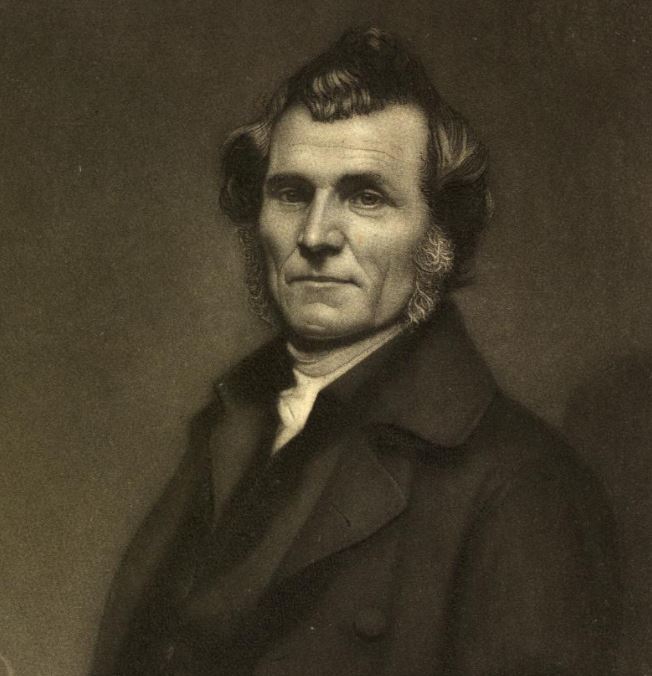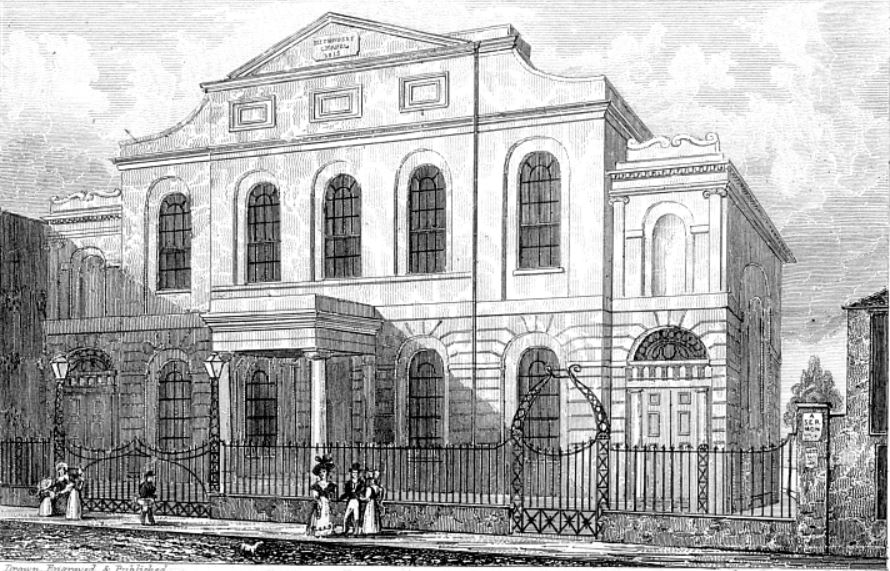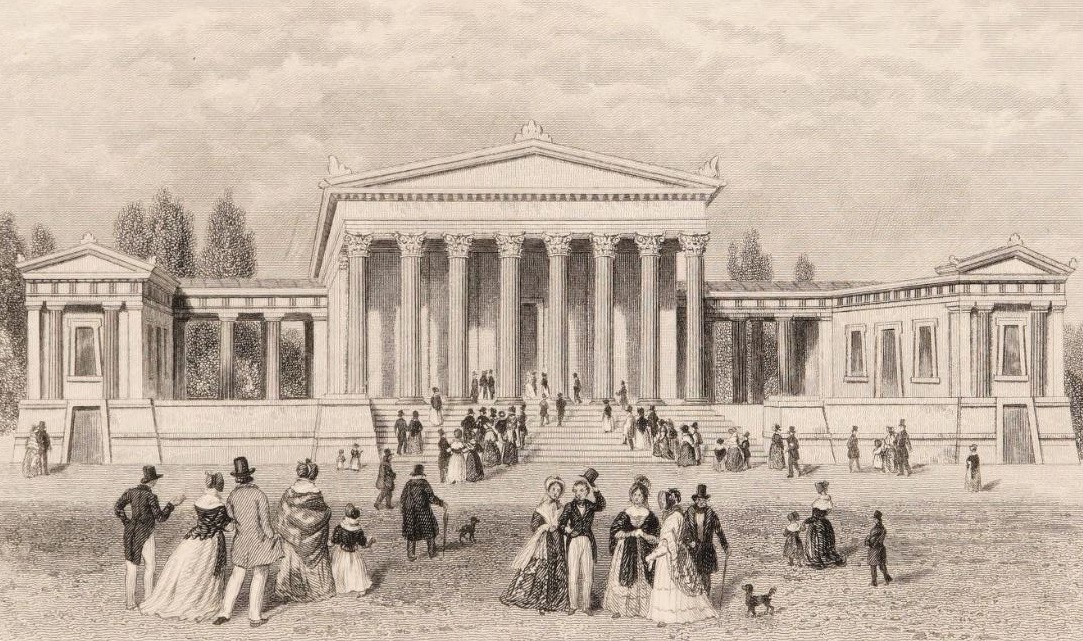

Background of James Caughey’s Ministry
We have already documented several other revivals led by the American Methodist evangelist, James Caughey. We highly recommend reading these accounts chronologically to gain a comprehensive perspective on this man’s ministry:
► 1827-1841 New York & Canada Revivals
► 1841 Ireland Revivals
► 1842 Liverpool England Revival
► 1843 Leeds England Revival

Evangelist James Caughey
The Start of the Hull, England Revival
James Caughey had just completed his role in the 1843 Leeds Revival, and departing Leeds on September 13, 1843, he began a brief tour of several European countries. Upon his return to England that same autumn, he initiated revival efforts in the city of Hull.
During his first two weeks of preaching in Hull, Caughey wrote that he experienced a tremendous block from being able to deliver his messages. He explained the barrier with these words:
► “My mouth was almost closed.”
► “I had difficulty getting ideas.”
► The ideas “would die away on my lips.”
Caughey’s explanation for this barrier was that those in attendance were looking to him to preach with conviction power using his own efforts. The whisperings of the people at his stumbling discourses greatly humbled him, prompting him to reflect:
My soul was prostrated and humbled before God and man, and mourned in the dust.
One of the Methodist ministers in the town encouraged Caughey with these words:
Hold on; preach as you can; by-and-by the people will lay hold of the throne of grace for themselves, by faith and prayer. They will not do this, however, till they have learned the useful lesson—man can do nothing. Then we shall have a breaking down, such as you have not seen. This you may depend upon.
With that encouragement, Caughey’s sermons included various exhortations, directing the people to focus their attention on God rather than on James Caughey, the man.
Extraordinary Prayer
To counter the block in the revival, Methodist ministers in Hull organized and spearheaded prayer sessions, seeking the conviction power of the Holy Spirit, and this effort brought together hundreds of people daily for this purpose.
As the prayer movement gained momentum, it ushered in a profound transformation in the atmosphere, eventually leading to 350 conversions. Initially, services were conducted at George Yard Chapel, but they were later relocated to the more spacious Kingston Chapel.
With the change in location, the revival’s impact and influence continued to grow, resulting in approximately 280 additional conversions.
Unity among Ministers
Caughey commended the Methodist ministers in the town for their active engagement in the revival’s endeavors. In previous revivals, Caughey often found himself exhausted from leading prayer meetings and managing extensive follow-ups with new converts. However, in the Hull Revival, the ministers took on these responsibilities, relieving Caughey of these tasks and granting him more time for sermon preparation and much-needed rest.

Waltham Street Chapel – Hull, England
Waltham Street Chapel
After receiving an invitation from another group of Methodist churches in Hull, he commenced ministry at the Waltham Street Chapel, on December 31, 1843, and continued till January 17, resulting in about 40 conversion on the first day.
Profound Presence of God
One of Caughey’s remarkable observations about this revival was that the attendance was “beyond any thing I had yet seen in revival.” On weeknights, Waltham Street Chapel was filled well before the scheduled service time. These services were also said to have been:
Marked by a gracious and constraining influence from above.
Caughey provided a detailed account of a particular Friday night at Waltham Street Chapel when one of these “gracious and constraining influences” descended upon the congregation. He described the experience as follows:
► During the first forty minutes of the sermon, there was an awful solemnity, “a general calm…”; “a silent awe, that dares not move,” pervaded the vast assembly.
► So profound was the silence, that one would have supposed the falling of a pin could have been heard in any part of the chapel.
► From the fortieth to the forty eighth minute of the discourse, there were occasional flashes of divine power, succeeded by suppressed sounds from different parts of the congregation, indicting emotions of no ordinary character.
Caughey then offered those in attendance the opportunity to place their faith in Jesus for cleansing from sin. At that moment, he vividly described the heightened intensity of the presence that enveloped the congregation, convicting and constraining those present:
It seemed like some mighty rushing—like the bursting of a storm of wind upon some extensive forest. The entire congregation was in motion; some preparing to fly from the place, and others in the act of prostrating themselves before the Lord God of hosts.
Cries for mercy, and piercing supplications for purity of heart, were heard from all parts of the agitated mass—on the galleries, as well as throughout the body of the chapel; while purified souls were exulting in the loftiest strains of adoration.
Poor sinners were amazed, and fled; but some of them fell down, some distance from the chapel, in terror and agony. Many, however, remained, venturing the publican’s plea, “God be merciful to me a sinner!”
Caughey and other ministers were also overcome by the majesty of God that revealed itself:
My soul, full of holy awe, trembled before the majesty of God. Like Elijah, who covered his face in his mantle when the Lord passed by, I was glad of a place of concealment in the bottom of the pulpit.
…Rev. Thomas Martin, who was with me in the pulpit at the time, was so overpowered, that he could do nothing but weep and adore.
That weighty presence of God hovered over the congregation for about 25 minutes, then it lifted. Those who had not been able to gain entry to the building due to the size of the crowd experienced the same outside the building, with one man stating:
I don’t know what has been going on in the chapel, or how you have felt, but there was a very strange feeling came over me while I was standing at the door.
Caughey noted that such outpourings of the Holy Spirit were uncommon in his ministry, but that he did recall a similar occurrence happening just one other time, during services on the western shores of Lake Champlain. (That evidently took place sometime during his earlier years: 1827-1841 New York & Canada Revivals.)
Attacks against Caughey and the Revival
As is often the case in revivals, this one was no exception. Satan, the literal being who opposes all that is good, raised up voices in an attempt to discourage and undermine Caughey.
One of these voices belonged to a Hull newspaper that urged town officials to halt Caughey’s work. Additional forms of opposition included anonymous letters filled with insults and discouraging words. These efforts were aimed at weakening his determination to press on.
When confronted with a challenge for public debate, Caughey replied by citing a verse from Nehemiah 4:3, emphasizing that the work he was involved in was too vital for him to cease:
I am doing a great work, so THAT I CANNOT COME DOWN: why should the work cease, whilst I leave it, and come down to you?
Employing military imagery, Caughey vividly depicted how the truth of God’s Word triumphed, prevailing over all the forces of Satan:
Some of the hottest shot from the magazines of Immanuel have been cast into their intrenchments; and the execution has been tremendous. The roaring of the artillery has no sooner ceased, than the cries of the wounded, supplicating for mercy, are heard on every side, until my soul has trembled before the Lord God of hosts.

Great Thornton Street Chapel – Hull, England
Outpouring of the Spirit of Prayer
At the Great Thornton Street Chapel a powerful outpouring of the spirit of prayer unfolded during one of the services. The sequence of events began with an exhortation emphasizing the critical importance of increasing prayer for the revival to continue. When Caughey subsequently took the pulpit, he remarked that he was “accompanied with uncommon power.”
The congregation was then encouraged to kneel and engage in a few minutes of silent prayer. However, the silence didn’t persist long, as an intense, agonizing prayer, clearly guided by the Holy Spirit, gripped those praying. Not even 10 minutes into this universal fervent prayer, there was heard a chorus of others joining in the prayer, though at first unwillingly:
The cries of penitent sinners began to mingle with the earnest pleadings of God’s servants.
Earnest prayer ascended from almost every part of the chapel, even from the galleries, to a perfect tempest of human voices. Zion was now travailing for the salvation of sinners, and we were afraid to interfere.
This visitation of the spirit of prayer lasted about 45 minutes, and much like its sudden arrival, it gradually began to subside. The atmosphere left those present with a sense of “holy awe.”
Results of the Hull Revival
As to the extent of the revival, according to meticulous records maintained throughout its progression, approximately 2,300 individuals placed their faith in Jesus for their salvation.
Conservation of Fruit
During the last four evenings in Hull, Caughey found himself in the company of a sizable gathering of highly respected and influential preachers, small group leaders, and friends. It was during these evenings that he passionately emphasized, with deep emotion, the necessity of preserving the fruits that had been harvested.

Locations mentioned in this revival account, and perspective from major cities
Departure from Hull
On Saturday, May 4, 1844, James Caughey departed from Hull with the intention of ministering to the churches in Huddersfield. His initial work in Huddersfield met with significant success, but after a week, there arose a misunderstanding between Caughey and the Methodist believers in Sheffield. They assumed Caughey was to minister in their city at that time, and because they had already invested substantial resources in the printing and distribution of flyers and posters, they persuaded him to come to Sheffield, much to the disappointment of the Huddersfield believers.
This change of plans led to the 1844 Sheffield Revival, with its 3,352 conversions to Christ. Caughey did, however, return and commenced ministry in Huddersfield on December 1, 1844, and continued there till April 1845. Read more about that with the 1844 Huddersfield Revival.
Primary Sources
► Dictionary of Canadian Biography; Caughey, James by Peter Bush
► Dictionary of Evangelical Biography 1730-1860; Caughey, James by Richard John Carwardine
► Earnest Christianity by James Caughey
► Methodism in Earnest: The History of a Revival in Great Britain, in Which 20,000 Souls Professed Faith in Christ, and 10,000 Professed Sanctification by James Caughey
Secondary Sources
► Arrows from My Quiver by James Caughey
► Glimpses of Life in Soul-Saving by James Caughey
► Helps to a Life of Holiness and Usefulness by James Caughey
► Letters on Various Subjects by James Caughey
► Sermons & Devotionals by James Caughey by bibleportal.com
► Showers of Blessing from Clouds of Mercy by James Caughey
► The Life of General William Booth by Harold Begbie
► The Standing Doubt by James Caughey
► The Teachings of Holy Scriptures on Some Points in the Doctrines of Repentance, Faith, and Prayer by James Caughey
► The Triumph of Truth by James Caughey
Return to List of Revival Stories
Chet & Phyllis Swearingen:
Office: (260) 920-8248
romans1015@outlook.com
Beautiful Feet
P.O. Box 915
Auburn, IN 46706

